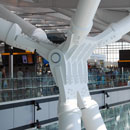Innovative Connections
Hidden or "Discreet" Connections
Making connections disappear. There are various reasons on a project to attempt to make connections disappear. This usually results in extra cost to the project as it usually infers that you have chosen not to do a simple bolted connection or are asking for a large amount of remediation of a weld to the point that it becomes invisible. This would include a lot of grinding, which is an expensive option and not to be considered before specifying AESS3 and higher. Grinding round shapes is very difficult and can result in additional marks to the steel due to the grinding "direction".
Before jumping to the "seamless appearance" requirement, it is useful to ask "why?" as this will add cost to the fabrication and erection and there might be alternate solutions that are more cost effective and suitable. It is best to consult with your fabricator/erector as they might have some helpful suggestions to create connections that are more discreet without being fully welded, ground and filled.
Always keep viewing distance in mind. If a connection is 6m or greater from the viewing position, the connection will have less visual impact and the viewer will be less likely to see seams and slight imperfections.
This canopy at Baltimore Washington International Airport needed to be fabricated in several pieces in order to ship the components. |
Although the trusses were predominantly welded, discreet bolted connections were used to connect the cantilevered portions to the main spanning truss at the bottom chord, while welded connections were used at the top for a clean appearance. |
Once the project has been painted, the bolted connections become fairly unobtrusive. |
And considering the function, it is unlikely that passengers would object to the cost savings that the bolted connecton provided! |
Erection challenges. In many instances connections need to be simplified or made more efficient (bolted) in order to meet erection schedules. Crane time is expensive and often lifts must be done at night if major streets or highways must be closed to allow proper access to the project. This will preclude the use of a welded connection as the time or access might not be possible.
The truss connections at the Eaton Centre/Dundas Square in Toronto needed to be unobtrusive. The majority of the truss is welded and bolts would not have been appropriate. |
Where there needed to be bolted connections these were done in a fashion similar to BWI above, and the connection covered with a simple plate system. |
 |
|
A closer view of the plate cover for the hidden bolted connection. No effort has been made to conceal the joints in the cover. The painted finish and location were deemed sufficient to make it less noticeable. Inside of this sleeve sits overlapping plates with bolts - much easier to erect than a welded connection. |
The erection of the Dundas Square Media Tower had to take place at night due to access issues. Here the same bolted connections were used, but the cover plates well sealed to prevent the entry of water that could cause corrosion. Consider who difficult it would be for the ironworkers to access the high connections for welding, grinding and filling. That adds cost to the project. |
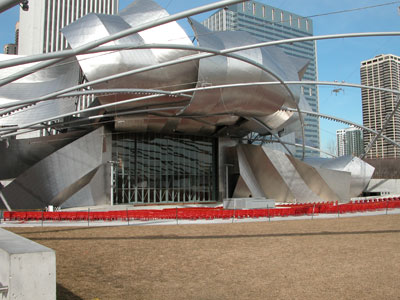 |
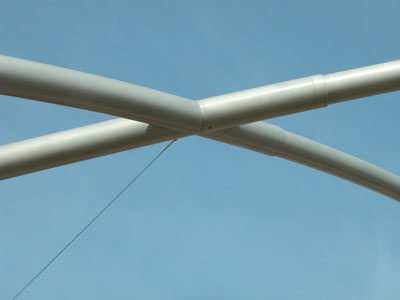 |
The large round HSS frame over the field at the Pritzker Pavilion in Chicago had to be designed to be spliced. The lengths of the curved tubes far exceeded transporation lengths. Shoring towers were required to support the lengths until all were in position and they became self supporting due to their curved geometry. |
Welded splices of the tubes are barely perceptible to the eye. Larger tubes are used at the edges of the field and smaller ones in the center, allowing for a sleeve type arrangement completed by welding. The field under the Millennium Park structure was covered with scaffolding and support towers during construction in order to access these joints for finishing. |
Extraordinary costs in hidden connections. In some instances hidden connections can result in very high costs to a project. Bear in mind that if filler is used to conceal joins or lines between components that any movement of the structure will likely result in damage to the joint.
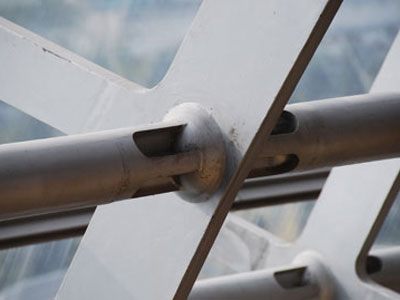 |
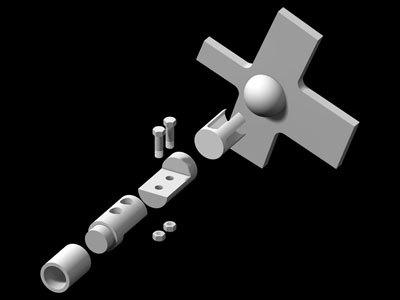 |
The Chinese National Theatre in Beijing went to extraordinary lengths to conceal the connections between the round HSS members and the plate trusses! |
This exploded drawing shows the components of the bolted assembly. Much filler was used to cover the bolt holes and joints between the steel. More information and images on this project here. |
Creating a language of connections. Even where highly worked connections are required for some connections on the project, the entire project need not use such expensive processes. This is often the case when making connections between tubular HSS members. Sometimes the use of a simple plate can allow for simpler welded joints that are even more attractive than would have been a very difficult welded connection of one tube to another, minus the plate.
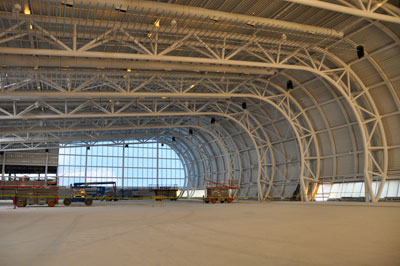 |
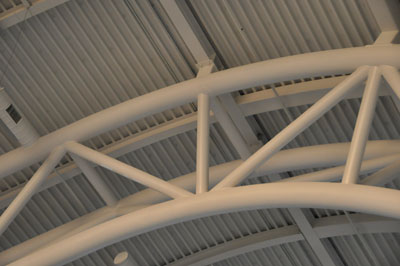 |
The triangular trusses used at the Abilities Centre in Whitby, Ontario by Bregman and Hamman Architects used welded connections to create the joint between the vertical and horizontal trusses. Here it was worth the extra expense/trouble to weld as any other bolted option would have detracted greatly from the appearance of this AESS4 project. |
The horizontal truss is welded to the vertical element. The vertical element terminates at the end of the curve. Evidence of the welded connection is completely concealed. This took a lot of care and careful planning. It was important to locate the weld in the straight lengths as the bending process can deform the steel, making for misalignment of the pieces. |
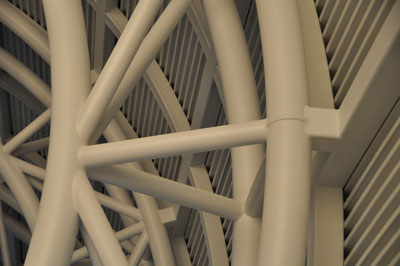 |
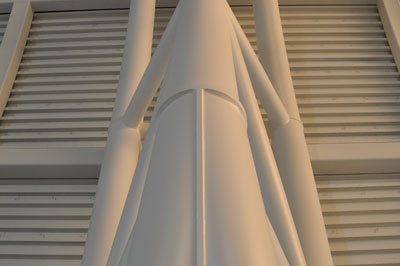 |
It is easier to create a smooth welded appearance if the web members of the truss are smaller than the outside chords. This leaves more room for welding. The plate that is inset on the curved member provides for a nice looking splice. There is a limit to the length that can be curved and if splicing or connecting steel that is differently curved, you can have bad alignment. |
The base of the trusses required that the single bottom chord member divide into two pieces for added stability. The use of the inset plate allowed for much easier fabrication and a very nice looking detail. This language of the inset plates is used consistently in the project and as a result adds to the aesthetics rather than looking like a simpler solution. |
